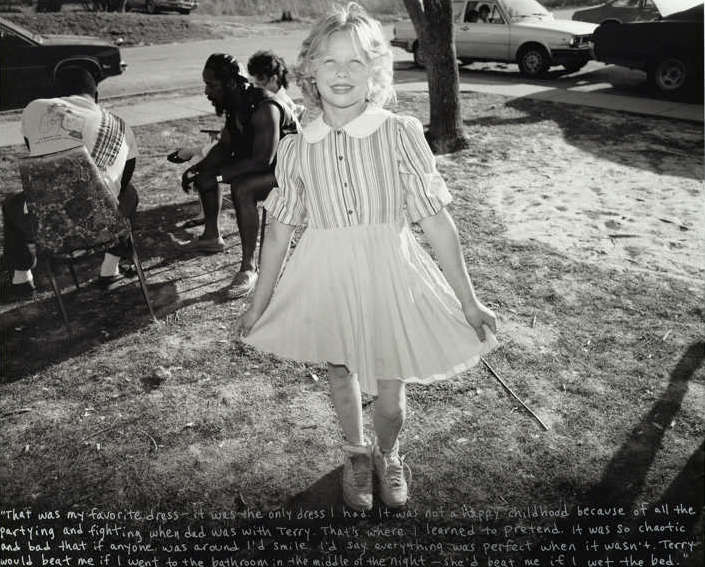
Accueil > Les rubriques > Appareil > Société > Revenants
Revenants
, et
Jeffrey Wolin’s work is essentially one of making portraits in which words - often handwritten on the picture - act as a detonator whose grenade is the picture. This work is occupied by memory. Furthermore should we rather say that it is haunted by the survivors. Jeffrey Wolin’s pictures are portraits and those who accept to pose for him are alive, but they all come back from "far away".
(translation Anne Hémion)

- Wendi on Illinois Circle, Pigeon Hill, 1990
- “I was only four when I saw my first stabbing—a drug deal gone bad. I knew I had to be tough just to survive on Pigeon Hill. My mom was a nurse but she got into drugs and left when I was nine. Odds were I’d have a kid by the time I was fifteen, like many of my friends. But I didn’t want that—I wanted to get off the Hill.”
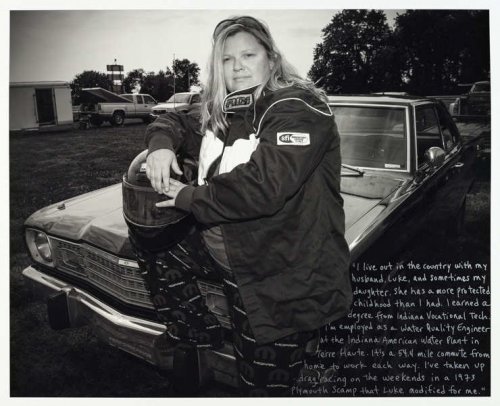
- Wendi at Lyons Raceway, 2013
- “I live out in the country with my husband, Luke, and sometimes my daughter. She has a more protected childhood than I did. I’m employed as a Water Quality Engineer at the Indiana American Water Plant in Terre Haute—it’s a 54.4 mile commute from home to work each way. I’ve taken up drag racing on the weekends in a 1973 Plymouth Scamp that Luke modified for me.”
The reason why he picked these men and women lies in the fact that they carry pieces of memory which newspapers or books do not mention, the memory of the events as they have been experienced by singular individuals.
Because there is a gap which often turns into a quartering between reality as seen by the media or accredited by history and the way facts are embedded in flesh and bodies. The only way to decrypt this particular memory is to admit that it is fundamentally intangible. More accurately, the only way to comprehend it is to take into account - in addition to the blinding evidence of the picture - of this rubble of pain that the human mouth spits out in the shape of words.
Voices
Each person photographed by Jeffrey Wolin has directly experienced a drama. Each individual memory is used in this series of portraits as a paradigm for one of these dramas that have profoundly torn History. Diving through personal remembrances rises to the surface memories which still torment each protagonist’s flesh, despite the years that have elapsed. It is an attempt to make elements which could look like flesh-and-blood-coloured touches on an abstract painting or on pictures from a black and white comic come up to the surface - the surface of image which is also the one of oblivion.
A lot of those he photographs come back from far. They experienced the camps or war in Vietnam and survived them but in the years that followed, the ruthless and destructive twists of fate didn’t spare them.
In a way, photography provides them with a body, a surface, a magic support from which their voices can be heard. We can hear them through the mediation of words they pronounced, and which are most of the time handwritten on the picture they appear in. Those revenants thus are ghosts or specters that have the ability to be heard. Nonetheless, through realistic and documentary appearances, photography renews one of its major function, the evocation of spirits. Because beyond the personal story of these living persons, it is precisely the fact that they’ve become ghostly shadows of themselves that matters. And beyond their status as specters, it is the dead people they knew, whom they left behind in death camps or in battle fields, that are posthumously justified through singular being’s memories.
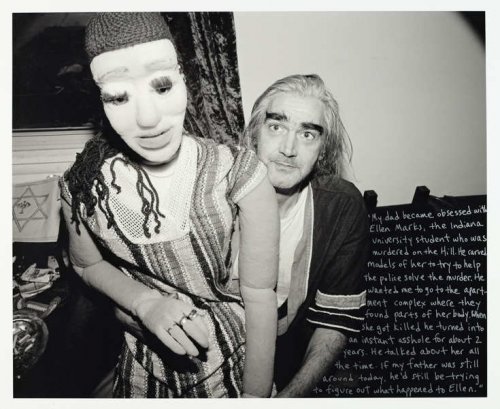
- Kenny, a Few Days Before His Death, Pigeon Hill, 1991
- My dad became obsessed with Ellen Marks, the Indiana University student who was murdered on the Hill. He carved models of her to try to help the police solve the murder. He wanted me to go to the apartment complex where they found parts of her body. When she got killed he turned into an instant asshole for about two years. He talked about her all the time. If my father was still around today, he’s still be trying to figure out what happened to Ellen.”

- Ken Lee w/ Cicada Killer, Pigeon Hill, 2013
- “My dad was a bondsman—it’s kind of like a bounty hunter. He’d find people and get 10% of the bond. We never lived in the same place very long—we kept moving. Dad taught me to hunt when I was 7 or 8. Taught me how to fish. He took me to visit the Nez Perce Indian reservation when I was 9 or 10. The hair is to show respect for my tribe. A couple times a week I walk through the house burning sweetgrass to keep evil spirits away. I learned the ritual from my dad. We were always close. When he died of a heart attack I was mad at the world. He cried out, ‘I hurt !’ I grabbed him ‘cause he started falling. He was dead before he hit the floor. Since he died it’s a big chunk of my life missing. My son, Jesse, was born 9 months later. He’s got my dad’s eyes.”
Doubles
Magic and justification are the two major functions of photography. Jeffrey Wolin uses it in order to provide recognition for a kind of memory which can’t hardly be found anywhere else. He works from an agnostic point of view but the intertwining and the complementarity of words and image - which men think of as two main means of communication - allow us, beyond personal beliefs, to explore these singular mental productions that paganism but mostly Christianity never stopped calling for under a mask of promises. Memory is co-essential to the picture as well as to the text.
Thus, we must look for their difference in function in order to understand the kind of system Jeffrey Wolin sets up. For sure, these "doubled" pictures he made twenty years apart and that are exposed for the first time here in Lyon show an accomplishment.
Specters and ghosts act like doubles for the beings they represent. The picture is the double of the one it shows. The text, especially when inscribed directly on their skin, makes a double out of the model - and at the same time its underside or its reverse.
In the new series about the inhabitants of Pigeon Hill, Jeffrey Wolin does not only continue a twenty-year-old project about those who live in the United States and who seem to be thrown from time immemorial into a daily struggle with violence and poverty. He brings to it a new dimension, a radical reflection about what we call time.
It is important to notice that it is the use of the "double" that makes it possible to reverse our point of views about time. This reversal implies to point out the bipolar structure of image which he had only shown through the use of words - the image’s "other" - so far.

- Crystal w/ her Aunt Judy, Pigeon Hill, 1991/2013
- “Crystal was my favorite niece. On that day I had just got back from the asthma doctor with my son, Marvin. Crystal was close to Marvin. She didn’t have many friends. A lot of people wouldn’t hang around with Grubbs. Crystal was a happy kid with a big smile. She always said when she grew up she wanted to have kids and be a good mom. I’ll always miss her.”
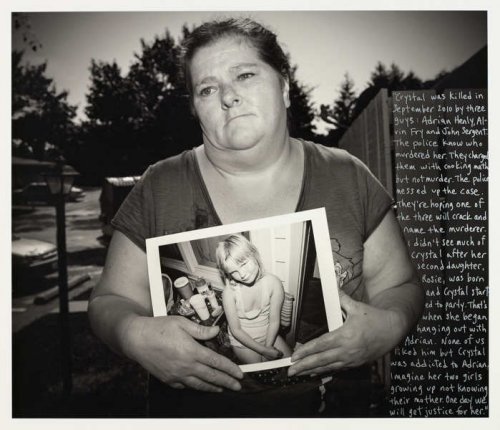
- Judy Holding Portrait of Crystal after her Murder, Acadia Court, 2013
- “Crystal was killed in September 2010 by three guys. Adrian Henley, Alvin Fry and John Sergent. The police know who murdered her. They charged them with cooking meth but not murder. The police messed up the case. They’re hoping one of the three will crack and name the murderer. I didn’t see much of Crystal after her second daughter, Rosie, was born and Crystal started to party. That’s when she began hanging out with Adrian. None of us liked him but Crystal was addicted to Adrian. Imagine her two girls growing up not knowing their mother. One day we will get justice for her.”
Stupor
This time, the entire system is split in two and redoubled at the same time. Those who were specters as pictures and specters to the American society - which, like the other developed countries, does not want to see those whose appearance and way of life don’t fit in its perfect imaginary organization - , being photographed for the second time twenty years later, find themselves confronted to their doubles. It’s as if they could see themselves or if we could see them in a mirror which would be able to reflect time as well as it reflects images. They’ve become their own mirrors.
We should no longer see Jeffrey Wolin’s photographies only as people’s reflections but as reflections of reflections, reflections of specters, specters of specters, squared ghosts. And the short texts which accompany them, somehow telling us what they’ve become or what happened to them during these twenty years, bring us to fall into an irrational stupor.
Of course, one doesn’t have to be a clairvoyant to know that these people had but a few chances to escape the destiny which every society promises to those who were born in poverty. In some way, because we look at them straight in the eyes, these people become the living proof of the implacable existence of a social destiny which is far from being a fairy tale.

- Kevin after He Was Shot, Pigeon Hill, 1988
- “A guy named Dirk shot me with a .410 shotgun out at Lake Monroe. We’d all been drinking. I heard the ‘pow’. I looked down and saw blood covering my leg. I used my shirt as a tourniquet—I’d just gotten out of the Marines. I took your photograph of my wounds to the prosecutor and it was used at the trial to convict him. He got 8 years and served a year and a half.”
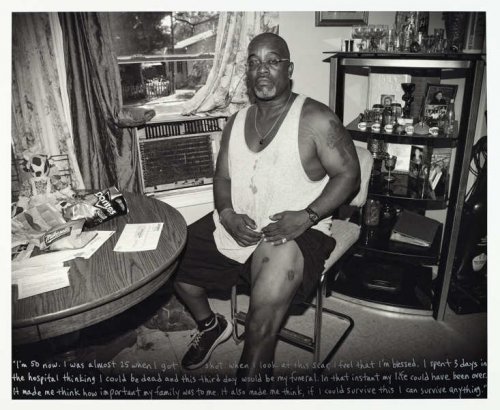
- Kevin w/ Scars, Pigeon Hill, 2013
- “I’m 50 now. I was almost 25 when I got shot. When I look at this scar, I feel that I’m blessed. I spent 3 days in the hospital thinking I could be dead and this third day would be my funeral. In that instant my life could have been over. It made me think how important my family was to me. It also made me think, if I could survive this I can survive anything.”
Time
Twenty years - enough for a baby to become a man proud of his strength or for a young and attractive woman to become a woman whose face we can read like an open book in which her destiny would be written down. Enough as well for liberty to be turned into prison, or the other way around. Nonetheless, when we look at these pictures, and despite these marking events which are told as briefly as a confession, it is impossible not to think that the time data is in some way biased, even false. At least deprived of any connection to what is really experienced.
If we only look at the sociological aspect of Jeffrey Wolin’s photographies, we might support the view that time is measurable and acts, in the end, as the measuring rod for everyone’s life.
The central illusion is obviously to think of time as a continuum, as a succession, as points that define a line, and that this line would be a text in which it would be possible to read the meaning of everyone’s life.
And, paradoxically, these pictures seem to question radically this illusion.
It is commonly accepted that time goes by according to the junction of individuals’ personal events. But as soon as we look at the social and emotional aspects of life, time does not seem to be a homogeneous idea nor an efficient measure. In his book Time : An Essay, Norbert Elias shows that our vision of time is not homogeneous but that it is made of two distinct aspects, physical and social time.
"The construction of time theories has thus been almost exclusively the task of physicians or philosophers that acted as their interpreters. By contrast, "social time" remained insignificant as a theme for theoretical researches or, more broadly, as an object of scientific investigation. And yet its importance in men’s social coexistence never stopped growing. We could even say that, by a kind of reversal of the effective course of events, it appeared as a derivative - more or less arbitrary - of "physical time", which is itself much more solidly structured." (Norbert Elias, op cit)
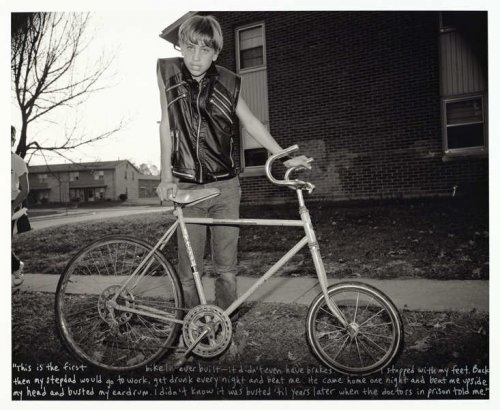
- Richard w/ Bicycle He Built, Pigeon Hill, 1989
- “This is the first bike I ever built. It didn’t even have brakes. I stopped with my shoes. Back then my stepdad would go to work, get drunk every night and beat me. He came home one night and beat me upside my head and busted my eardrum. I didn’t know it was busted ‘til years later when the doctors in prison told me.”
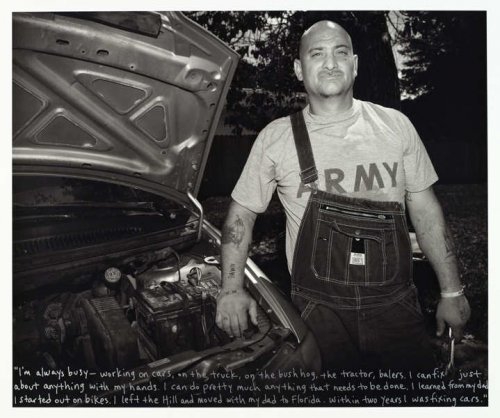
- Richard Fixing a Van on the West Side, 2013
- “I’m always busy—working on cars, on the truck, on the bush hog, the tractor, balers. I can fix just about anything with my hands. I can do pretty much anything that needs to be done. I learned from my dad. I started out on bikes. I left the Hill and moved with my dad to Florida. Within two years I was fixing cars.”
Discontinuity
Jeffrey Wolin’s photographies dive in social time and allow the exploration of what it is made of and what makes its very existence.
Time on clocks picks off an infinity of instants that are supposed to make a continuous line. On the contrary, social time is made of discontinuous elements. The power of these photographies - separated by twenty years - is to make discontinuity visible by showing adjacent instants that don’t presuppose anything concerning any continuity whatsoever.
We should rather say that these pictures manage to make us put our beliefs about continuity aside, thanks to the doubling of each picture which is at the same time explicitly simple and extremely rich in meaning.
Every couple of pictures literally put under our noses the fact that passed time, mental time, emotional time, and social time are not subordinated to physical time.
Indeed, each picture is an instant. What’s important here is not to refer to the physical and technical time of the shooting but to the idea that each picture includes the protagonists’ "voice" through the mediation of the text and that, when doubled, it makes the discontinuity of instants materially perceptible.
In a few sentences, the text abruptly reveals individual lives that only become stories because we put the two moments together. Supposing that continuity is necessary, we are the ones who build the bridge between these two sentences. And we call it history, taking it as time.
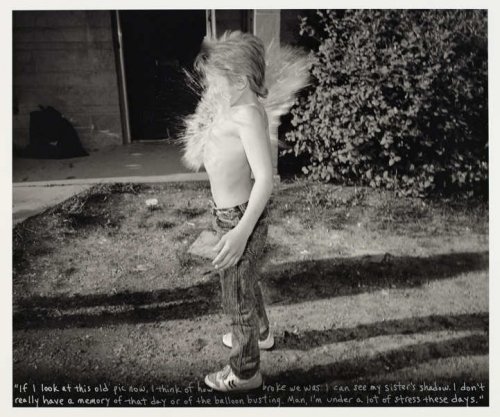
- Stevie & the Water Balloon, 1989
- “If I look at this old pic now, I think of how broke we was. I can see my sister’s shadow. I don’t really have a memory of that day or of the balloon busting. Man, I’m under a lot of stress these days.”

- Steve w/ Son, County Line Road, 2012
- “I look at this pic and think, I might have been porr as a kid but now I work so much that it don’t mater—I don’t have time for life. So did I have it worse or do my children ? I don’t know.”
What we see
And yet, what we see is somehow the opposite of a story. What we look at are precisely two distinct and thus discontinuous events, two disparate instants whose only connection is the rigidity of social bound as created by a "social point of view". What we see are the stigmata left on the branded flesh of those who used to be outcasts. What we see is destiny hesitating, even though it looks like it has subordinated these bodies. Seemingly insisting on the protagonists’ identities, these pictures show that nothing is possible but what’s already inscribed in people’s flesh by the social context they were born in. Life followed a path which is not carried by time but by its absence, at least as a power of transformation. What we see is the "self-ghost" through the ghost of the other. What we see is the "non-truth" of time as an orientation medium. What takes place in front of us is existence demonstrating its power of inscription and crushing, which both exist outside of regular forms of time. What we see is time - time as a distance - crushing and a new dimension of existence appearing - a dimension strictly psychological and independent from real life conditions in which life builds itself up and destroys itself at the same time. What we see is something quite new - the idea that dreams are not motion pictures but a succession of still images. We are the ones who create, build, impose continuity by putting these distant unities into one big bowl of the dreamed-time soup. What we see is that continuity doesn’t necessarily provide meaning but that without it we are lost. What we see is life when we look at it discontinuously. What we see is the tempest of eternity striking earth like a plague of crickets. What we see is the impossibility to decide whether we re dead or alive. What we see is that "We are such stuff as dreams are made on, and our little life is rounded with a sleep"(W. Shakespeare, The Tempest, Act 4, Scene I).
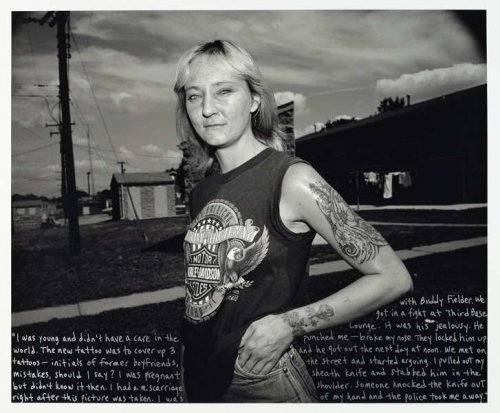
- Tina w/ New Tattoo, Pigeon Hill, 1991
- “I was young and didn’t have a care in the world. The new tattoo was to cover up 3 tattoos—initials of former boyfriends, mistakes, should I say ? I was pregnant but didn’t know it then. I had a miscarriage right after this picture was taken. I was with Buddy Fielder. We got in a fight at Third Base Lounge. It was his jealousy. He punched me—broke my nose. They locked him up and he got out the next day at noon. We met on the street and started arguing. I pulled out my sheath knife and stabbed him in the shoulder. Someone knocked the knife out of my hand and the police took me away.”
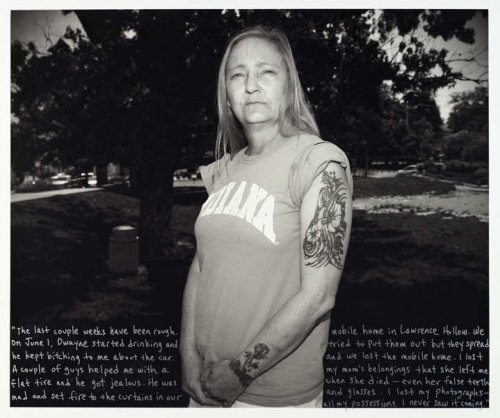
- Tina after the Fire, Middle Way House, 2013
- “The last couple weeks have been rough. On June 1, Dwayne started drinking and he kept bitching to me about the car. A couple of guys helped me with a flat tire and he got jealous. He was mad and set fire to the curtains in our mobile home in Lawrence Hollow. We tried to put them out but they spread and we lost the mobile home. I lost my mom’s belongings that she left me when she died—even her false teeth and glasses. I lost my photographs—all my possessions. I never saw it coming.”
Voir en ligne : http://www.jeffreywolin.com/

